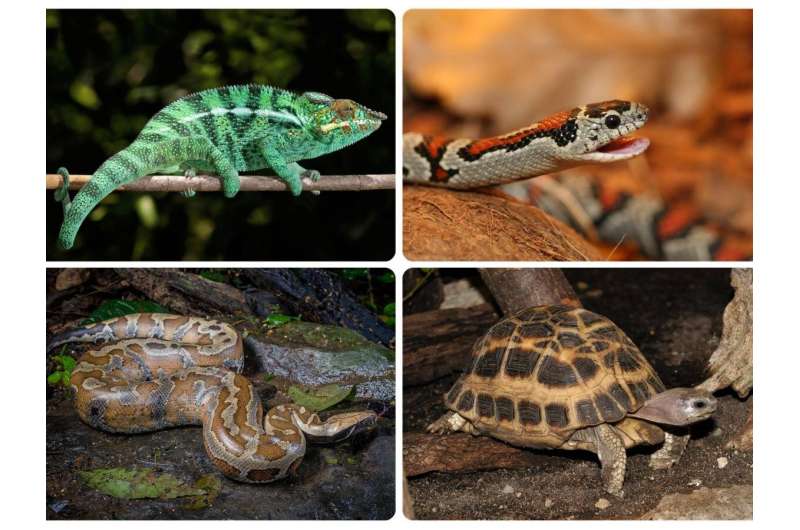Reptile species at high risk of illegal trade. Credit: F. pardalis by Charles J.Sharp; L. mexicana by PetrBrož; P. brongersmai by Tontan Travel; and P. arachnoides by Klaus Rudloff
The transnational smuggling of live animals poses a threat to Australia's biodiversity, conservation, environmental biosecurity, animal welfare, and human health and wellbeing.
In a study published in Conservation Letters , researchers at the University of Adelaide compared the illegal smuggling of live reptiles—including lizards, snakes and turtles—into Australia, to the unregulated pet trade of reptiles in the United States (US), to understand better the drivers of illegal wildlife trade, and develop a framework for anticipating future trends in wildlife smuggling.
The researchers suggest the unregulated reptile trade in the U.S. and other Western countries, has a major influence on Australians' desire for illegal reptiles.
Lead author, Dr. Oliver Stringham from the University of Adelaide's School of Biological Sciences, said, "There has been considerable attention paid to the scale of the wildlife trade in non-Western countries, but much less on large Western markets, even though trade has been happening in Western countries, such as the U.S., for a long time.
"The U.S. markets drive many aspects of Westernized culture, such as fashion, music and fast-food, so the influence of the U.S. on reptile pet trade has the capacity to be substantial."
In the study, the researchers modeled the probability of reptile species being smuggled into Australia using U.S. trade data, U.S. reptile pet store inventories, and other reptile trait, taxonomy and trade-based variables.
The researchers found of the 75 reptile species reported as smuggled into Australia between 1999 and 2016, all but one were also found in the unregulated U.S. trade. On average, a species was first smuggled to Australia around six years after first appearing in the U.S..
Three reptile families had the highest probability of being smuggled. They were, Elapidae (such as cobras and mambas; all venomous), Kinosternidae (small turtles such as mud turtles and musk turtles), and Testudinidae (tortoises).
Species listed in Appendices I of the Convention on International Trade in Endangered Species (CITES) of Wild Fauna and Flora, had a higher smuggling probability compared to species not listed, after controlling for other variables.
"It is our interpretation that the recent demand for illegal species in Australia has therefore originated from species already present in the U.S. pet trade rather than new emerging or exotic species," said Dr. Stringham.
"We provide the first evidence that market-level indicators of legal wildlife trade in the U.S. have a strong predictive power to discern which species are smuggled illegally into Australia.
"Our research also provides the first risk watch-list of desirable reptile species trafficked into Australia, and a framework for anticipating future trends in wildlife smuggling."
Associate Professor Phill Cassey from the University of Adelaide's Invasion Science & Wildlife Ecology Lab said, "Western countries play a prominent role in the legal and illegal wildlife trade, but particularly in exotic pet keeping.
"We hope these findings assist to assess and anticipate the risk of exotic live animals being smuggled into Australia and other Western countries, and will encourage further research into the patterns and drivers of live animal smuggling."
More information: Oliver C. Stringham et al, Live reptile smuggling is predicted by trends in the legal exotic pet trade, Conservation Letters (2021). DOI: 10.1111/conl.12833
Journal information: Conservation Letters
Provided by University of Adelaide
























